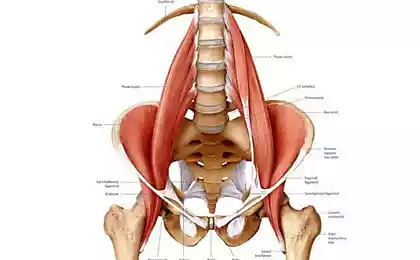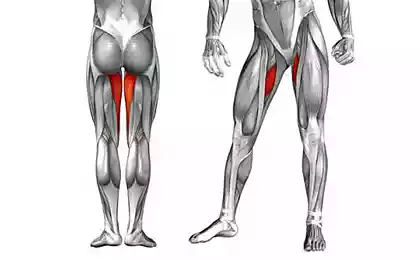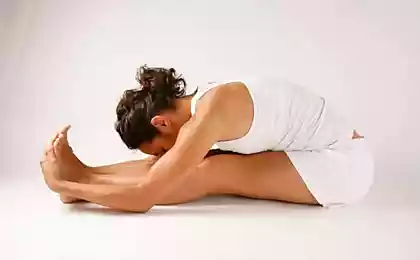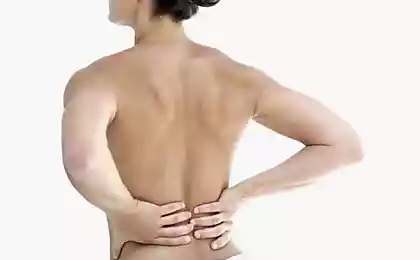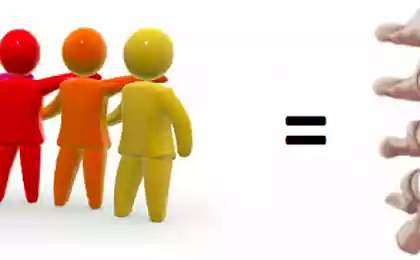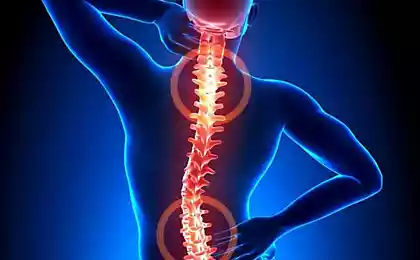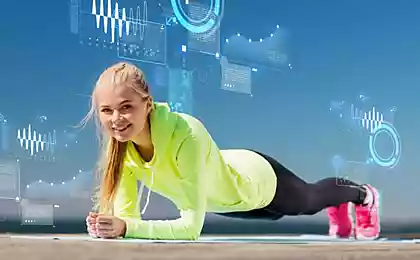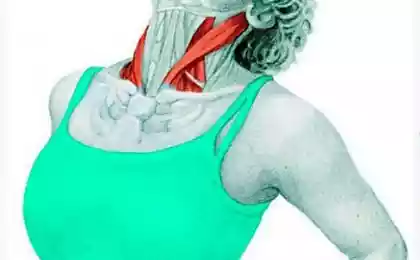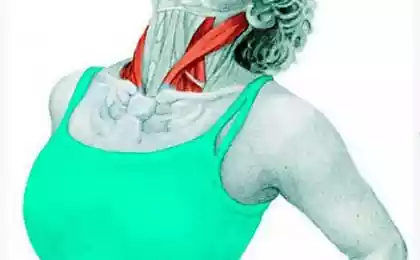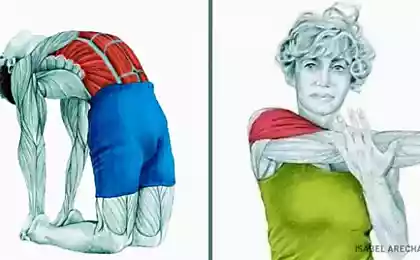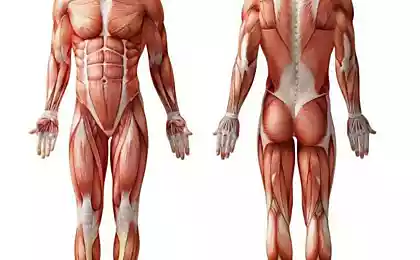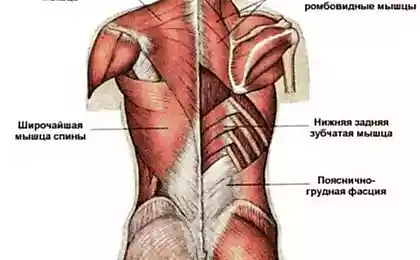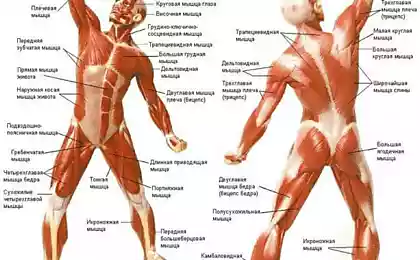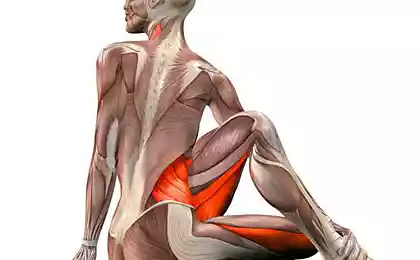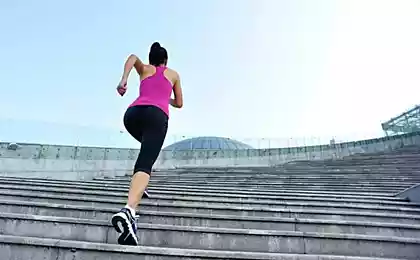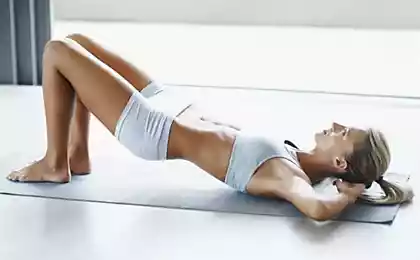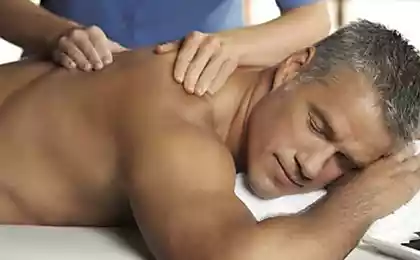752
Postisometric relaxation of muscles: exercises for a correct position of spine
All joints of the human body surrounded by systems of muscles and are driven by their abbreviations. The reduction of some muscle groups and timely relaxation of the others were the smooth performance of body movements.
When pathological displacements in the joints of the effect of pronounced irritation of the receptors of the tendons, muscle fibers. This leads to a reduction in as small groups periarticular muscles, fixing abnormal position of a joint, large muscle-fascial complexes, leading to changes in the biomechanics of the entire body.
Treatment of these complex disorders should lie in the causal joint return to normal position and range of motion. Unfortunately, pronounced periarticular muscle tension hinders the body holding self-correction.
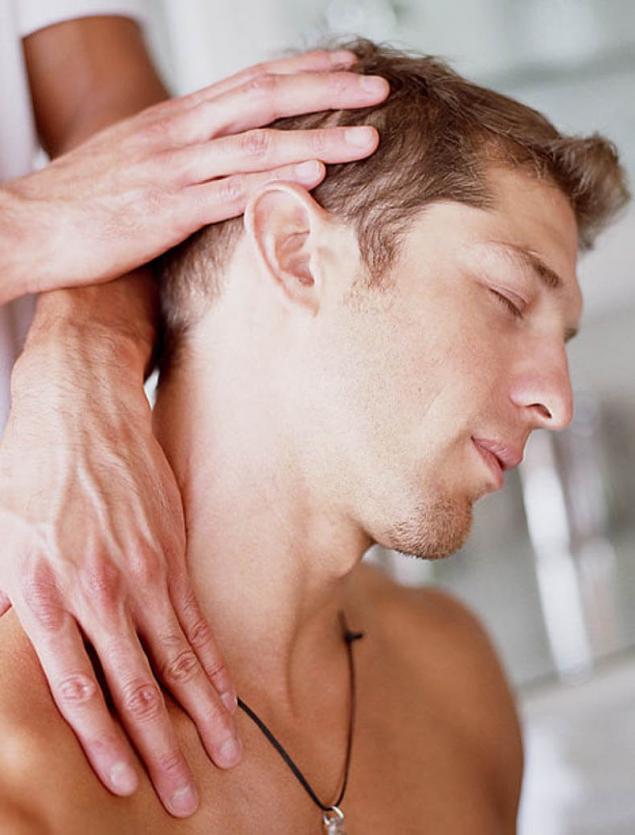
To help the body get back on the path to healing it is necessary to spend the relaxation of muscles.
It is known that in the phase of normal muscle contraction is the depletion of domestic energy resources of the muscles, followed by relaxation phase. In the case of pathologically tense muscles alternating activation of different groups of fibers, which allows muscle long-term is in a stressed condition.
If we consciously increase the force of muscle contraction in response to applied from the outside resistance, and will involve all groups of muscle fibers, leading to their subsequent relaxation and will provide an opportunity to stretch the tense muscles, to release pathologically displaced joint.
The basic rules of a postisometric relaxation of muscles.
1) Before the beginning of the exercise need to be joint in the direction of constraints to achieve maximum tension and tension is pathologically shortened muscles. The preparatory movement is performed until the gain level of pain manifestations. It is a barrier restricting movement.
2) Motion carried to increase muscle reduction, should be performed in the direction of maximum pain and a to comply with the direction prior to the muscle contraction (the opposite barrier restrictions).
3) the additional contraction of the muscles is 30% of maximum and should not increase pain symptoms.
4) Resistance to contraction of the muscle must be sufficient to hold the limb or body move in space. Muscle needs to strain, but do not produce movement, held by the resistance.
5) Time additional muscle tension for 5-7 seconds.
6) After the voltage is aged 3 second pause – the muscle relaxes.
7) After the pause is stretching the muscles in the side of the barrier to limit the appearance of pain syndrome. This is a new barrier restrictions.
8) is Performed 3-4 passes with a gradual increase in freedom of movement and relaxation of muscles.
Examples.
The lumbosacral spine.
The most frequent complaint of patients with pain syndrome of the lumbar-sacral level is the pain extending from the loins to the sacrum and pelvic region, spreading over the back of the thigh. This pain pattern (feeling) occurs when the piriformis muscle spasm with involvement of ligaments, the gluteal muscles and of the flexors of the lower leg. The correction is carried out the following exercises.

Exercise 1. I. p. — lying on back, one leg bent, the foot is mounted to the outer surface of a straightened knee healthy feet. The opposite hand grasps the knee on the outer side (Fig. a).

Pull the leg over the knee towards the opposite shoulder. The normal angle is forced to bring the thigh of the provision is equal to 45°. This may appear weak, painless tugging sensation along the thigh (along the "stripes"). If up to 45° will appear a nagging pain in the buttock from the sacrum to the hip joint, it is necessary to produce postisometric relaxation of the piriformis muscle in the direction of the most pain.
To do this, try to take the bent (the patient's) leg out to the side, holding the movement by hand. Take a breath. The force should be small or moderate in intensity and do not cause pain (a). Hold this position for breath for 5-7 seconds, relax your leg and hand to pull the knee itself is in a diagonal direction to the opposite shoulder (b). If done correctly, the spasm will subside, the pain threshold will be overcome, however, increase the angle to bring the thigh. Repeat a series of stretching until the maximum angle. Your goal — to bring the thigh to angle slightly exceeding 45°.
Possible technical difficulties with this exercise:
During the stretch there is a sharp pain or spasm in the gluteal region. The exercise should stop, relax and try to run again with minimal effort, the legs can not be crossed. Use option (a) or (b) of this exercise.
— If in the same situation except the pain came the numbness in the posterolateral surface of the thigh, leg and several toes, it indirectly shows the compression of the branches of the sciatic nerve which passes beneath piriformis muscle and sometimes through it.
In this case, your actions are the same. Also, please note, do not turn together with foot the pelvis and lumbar spine, as the pain can be a result of the gain compression of the nerve root directly in the spinal segment. In any case, these symptoms suggest the seriousness of this disease and require a more gentle stretch marks (a, b) with subsequent thermal effects (jet hot shower).
— If the pain when stretching appeared in the groin, and the feeling that the leg was across the way, that is likely the cause of the arthrosis of the hip joint and the achieved traffic — this is your individual norm.
Pay attention to the fact that the pelvis when performing the stretch must be fixed. To control its position and the best relaxation of the muscles can be put under the buttocks fist of the free hand.
Exercise 2. I. p. — lying on his stomach, leg bent at the knee joint, the tibia is diverted sideways at the same time, if the muscles relax, the hip will move relative to the longitudinal axis outwards (a). From the sacrum to the buttocks will feel the tension. Strain the muscles in the gluteal region, preventing the rotation of the hip, and hold that position for 5-7 seconds on the inhale. Relax your muscles, do a relaxed exhale. Due to the weight of the foot and lower leg will be a natural stretching of the muscles. The angle of deviation in the norm would be 45° (b).

Exercise 3.
This option allows for stretching not only the piriformis but also the entire group of abductor muscles. It is preferable to apply it during the prevalence of pain at the posterolateral of the thigh.

I. p. — lying on the healthy side (preferably on the couch or the couch), lying on the bottom arm extended and locks the torso motionless, the other hand located the gluteal region to control the movements of the pelvis and massage the painful spots. Underpad (healthy) leg is straight, the one at the top (patient); Phillips wound up and hangs over the edge of the couch (a). Bending and unbending the leg in the hip joint, choose a position in which pulling top brass would feel the maximum, and from this position, spend PERM. Exercise as well is carried out by gravity, as in option A. On the inhale hold the foot horizontally for 10-15 seconds (a). Then on the exhale, relax the leg falls under its own weight, stretching the muscles (b).
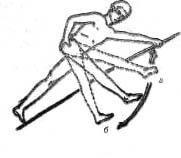
After performing FIRM and reduce pain, it is advisable to perform exercises to improve joint mobility of the pelvis and lumbar spine.
They are lying, which eliminates the gravitational overloads in the intervertebral discs.
Exercise 4.

I. p. — lying on back, one leg bent at the knee and hip joints, hands chained to the castle and fixed just below the knee (a). Hands pull knee toward the same shoulder, and make a rocking motion back and forth, as if rocking the spring. The amplitude of movements should be minimal and take place in most range of flexion in the hip joint.
Keep on rocking and move the knee, directing it to the opposite shoulder (b). Normal movement is painless and thigh with rocking lays on the stomach. If any of the provisions felt a nagging pain in the gluteal region, then it should perform PERM: strain of muscle and try to take a knee from the stomach, preventing this movement with your hands. Lock this position for 5-7 seconds, then relax your muscles and hands to guide the rocking motion in the painful plane to a comfortable feeling.
Exercise 5.
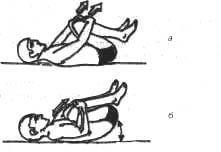
I. p. — lying on back with legs bent and pressed against his stomach. Put your arms around your knees and try to take the thighs from the stomach, preventing the movement of the hands (a). Hold the tension for 5-7 seconds, then relax, with your hands pull your knees up to the stomach and perform a swaying motion itself, and (b). The pelvis is lifted and the lower lumbar segments will be in a position of flexion. Thoracic, cervical spine and head should lie on the same plane. Repeat this exercise 3-4 times.
Exercise 6.
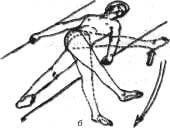
I. p. — lying on your back (preferably on a couch), shoulder girdle pressed. One leg outstretched, the other cruciate is put in the opposite direction of the pelvis while deployed. The leg should relax and stretch, and then try to lift it with the muscles of the back (a). After fixing this position for 10 seconds, the muscles need to relax.
Leg under his weight drops and deploys the pelvis. Realized post isometric relaxation of the lumbar muscles. In the joints of the vertebrae there will be a rotation and if you add rocking motion with your foot up and down with increasing amplitude, their mobilization (b). This movement may be accompanied by clicks, after which there is usually pain relief. Changing the angle of flexion of the leg in the hip joint, you can subjectively find the most optimal position. If necessary, the movement is repeated in the opposite direction.
If you feel back pain radiating to sacral region without extension to the lower limbs and they are worse after long sitting, more concerned in the morning and require "rassharivaniya", it says defeat is not so much the intervertebral disks (osteochondrosis), but the presence of a disease of the joints of the spine — spondiloartrozy.

In this case, in addition to these techniques PERM useful to conduct additional stretching of the muscles of the lower back.
Exercise 7.
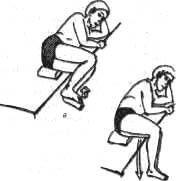
I. p. — lying on the edge of the bed on the healthy side, under pelvis and lower back can put a small pillow. Both legs bent at the knee and hip joints, leg and foot hanging over the edge of the bed. Due to the weight of the legs when relaxation happens the tilt of the pelvis and overlying the side feel a stretch.
Lift the foot and lower leg to a horizontal position, hold the tension for 5-10 seconds (a). Movement to perform better on the exhale. Then take a deep breath, relax and stretch. The legs will drop and your weight will stretch the square of the loin muscles and the intrinsic muscles of the spine (b). The motion is repeated 3-4 times with an increase in the amplitude while stretching.
If conditions permit, you can "top" with your hand to grab the headboard. In this case, the stretching is palpable and will capture the widest muscle of the back.
Exercise 8.
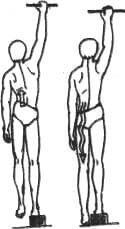
Allows you to stretch those muscles and relieve the joints and discs of the spine. It is more suitable for those who have pain in the evening. To run it put next to the closet pile of books the height of 15-20 centimeters. If your house has a crossbar, it is better to use it, although suitable and the door, or at least just the wall, on which to build.
I. p. — standing with one foot on a stack of books, the other hangs freely without touching the supports, hands stretched up to the maximum, fix the position, holding for support. On the exhale, pull up hanging leg-up ("pull" his leg in the body), as shown in Fig. 35. Holding this position for 10 seconds, breathe, relax and shake a leg hanging down, trying to touch the foot of the floor (b). Normal should feel the stretch of muscles in the lumbar region on the side dangling his feet. Repeat the movement 3-4 times for each leg.
After completing this exercise, you need to go and lie down for hours, so it is best to do before bedtime.
Welcome PERM will be more effective if it is carried out from the position of visa on the bar on one hand. And if on the right, then pull left foot should be and Vice versa. This option is ideal for athletes and anyone who could do it, having hung on the crossbar for 2-3 minutes, holding on with one hand.
Exercise 9.

I. p. — lying on your back, legs straight. On the foot (near the toes) wear a long towel, like a stirrup. The ends hold it in my hands and pull the call. The leg will begin to rise, as we have said, are normal at 80-90°, that is released in a vertical position.
If the angle of elevation is smaller and, for example, after the 30° appeared nagging pain at the back of the thigh, behind the knee or in the tibia, it is the same (hidden) spasm of the muscles that must be eliminated, otherwise it will sooner or later manifest themselves clearly in the form of an exacerbation. -.to eliminate this spasm is used PERM.
First, slightly loosen the tension of the towel and set it back to a painless position of the feet. Then take a calm breath and press down with toes on a towel, as the pedal You will feel how tense the muscles in the back of his legs. Your effort should be moderate in intensity.
Hold the muscle tension for 7-15 seconds (and preferably hold breath). Exhale, slowly relax the muscles in the legs and hands pull the towel on yourself. If done correctly, effortlessly and jerks, that leg will rise above the original level and overcome the initial pain barrier.
Next, stretch the muscles to a new "threshold" — in our case, for example, from 30 to 50° to 70°. And as soon as already familiar tugging sensation, re-apply pressure with your fingers on a towel, hold the tension on the inhale, and stretch. Now the angle of elevation may reach 80-90°. So, for 2-3 cycles of spasm the vast majority is eliminated.
Often there is an opinion that similar pain associated with the inflammation of the sciatic nerve, but the exercise proves a muscular origin of pain, which is often possible to stop an easy stretch.
Possible difficulties with this exercise:
Exercise 10.
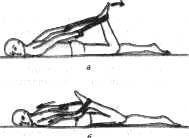
I. p. — lying on his stomach, one leg bent at the knee joint. On the foot throw in the towel, the ends of the clamp in his hands like reins. Pull up the towel to itself while the leg will bend in the knee and heel touch the buttocks. Might be slight painful sensation of tension at the front of the thigh, in the presence of hidden spasm of the extensors of the tibia and the heel does not touch the buttocks and the thigh will appear a nagging pain.
In order to release pain PERM is performed according to the General rules. On the inhale try to straighten the knee and maintain muscle tension for 12-15 seconds (a). After this, exhale and pull the ends of the towel on yourself. You will notice that the muscle tension will weaken and the knee bent at a larger angle (b). Not returning to original position, re-tighten your muscles and repeat the whole cycle of tension and stretching. So, gradually increasing the angle of knee flexion, you will pull heel to buttock.
Possible difficulties:
The exercises PERM are key for proper position of all upstream parts of the spine. In addition, they increase the reserve of the musculoskeletal system due to growth and the normalisation of traffic in two major joints — knee and hip. Now they will put them to perform range of motion and relieve the spine, and therefore, the risk of recurrent exacerbations of lumbar pain will be reduced.
If you perform these exercises regularly, then after a week or two you will notice that the legs are bent and unbent in full and without holding FIRM. In this case we can restrict the test 1 time per week using the same techniques, and the deviation from the norm to conduct stretching exercises.
Recall that the main criterion of correctness of the techniques PERM are not degrees, and your feelings. In exercise 1 drawing sensations should be in the muscles of the thigh and lower leg rear side, the second from the front.
Flatfoot is not a harmless disease!
Unknown "body inside body": the cause of unexplained diseases and syndromes
If the feeling has moved to the joint: in the first exercise — in the hip (pain in the groin area), and the second in the knee (pain in the popliteal crease), it means that the reserve stretching of the muscles are exhausted and you have reached your individual standards.
It can be smaller not only in different diseased conditions, but also with massive muscles of the thighs or obesity. In these cases, when the reserve stretching may be exhausted, it is important to remember that the ability of your musculoskeletal system are limited and do not give him excessive stress. published
P. S. And remember, only by changing their consumption — together we change the world! ©
Source: www.osteodoc.ru/met.htm
When pathological displacements in the joints of the effect of pronounced irritation of the receptors of the tendons, muscle fibers. This leads to a reduction in as small groups periarticular muscles, fixing abnormal position of a joint, large muscle-fascial complexes, leading to changes in the biomechanics of the entire body.
Treatment of these complex disorders should lie in the causal joint return to normal position and range of motion. Unfortunately, pronounced periarticular muscle tension hinders the body holding self-correction.

To help the body get back on the path to healing it is necessary to spend the relaxation of muscles.
It is known that in the phase of normal muscle contraction is the depletion of domestic energy resources of the muscles, followed by relaxation phase. In the case of pathologically tense muscles alternating activation of different groups of fibers, which allows muscle long-term is in a stressed condition.
If we consciously increase the force of muscle contraction in response to applied from the outside resistance, and will involve all groups of muscle fibers, leading to their subsequent relaxation and will provide an opportunity to stretch the tense muscles, to release pathologically displaced joint.
The basic rules of a postisometric relaxation of muscles.
1) Before the beginning of the exercise need to be joint in the direction of constraints to achieve maximum tension and tension is pathologically shortened muscles. The preparatory movement is performed until the gain level of pain manifestations. It is a barrier restricting movement.
2) Motion carried to increase muscle reduction, should be performed in the direction of maximum pain and a to comply with the direction prior to the muscle contraction (the opposite barrier restrictions).
3) the additional contraction of the muscles is 30% of maximum and should not increase pain symptoms.
4) Resistance to contraction of the muscle must be sufficient to hold the limb or body move in space. Muscle needs to strain, but do not produce movement, held by the resistance.
5) Time additional muscle tension for 5-7 seconds.
6) After the voltage is aged 3 second pause – the muscle relaxes.
7) After the pause is stretching the muscles in the side of the barrier to limit the appearance of pain syndrome. This is a new barrier restrictions.
8) is Performed 3-4 passes with a gradual increase in freedom of movement and relaxation of muscles.
Examples.
The lumbosacral spine.
The most frequent complaint of patients with pain syndrome of the lumbar-sacral level is the pain extending from the loins to the sacrum and pelvic region, spreading over the back of the thigh. This pain pattern (feeling) occurs when the piriformis muscle spasm with involvement of ligaments, the gluteal muscles and of the flexors of the lower leg. The correction is carried out the following exercises.

Exercise 1. I. p. — lying on back, one leg bent, the foot is mounted to the outer surface of a straightened knee healthy feet. The opposite hand grasps the knee on the outer side (Fig. a).

Pull the leg over the knee towards the opposite shoulder. The normal angle is forced to bring the thigh of the provision is equal to 45°. This may appear weak, painless tugging sensation along the thigh (along the "stripes"). If up to 45° will appear a nagging pain in the buttock from the sacrum to the hip joint, it is necessary to produce postisometric relaxation of the piriformis muscle in the direction of the most pain.
To do this, try to take the bent (the patient's) leg out to the side, holding the movement by hand. Take a breath. The force should be small or moderate in intensity and do not cause pain (a). Hold this position for breath for 5-7 seconds, relax your leg and hand to pull the knee itself is in a diagonal direction to the opposite shoulder (b). If done correctly, the spasm will subside, the pain threshold will be overcome, however, increase the angle to bring the thigh. Repeat a series of stretching until the maximum angle. Your goal — to bring the thigh to angle slightly exceeding 45°.
Possible technical difficulties with this exercise:
During the stretch there is a sharp pain or spasm in the gluteal region. The exercise should stop, relax and try to run again with minimal effort, the legs can not be crossed. Use option (a) or (b) of this exercise.
— If in the same situation except the pain came the numbness in the posterolateral surface of the thigh, leg and several toes, it indirectly shows the compression of the branches of the sciatic nerve which passes beneath piriformis muscle and sometimes through it.
In this case, your actions are the same. Also, please note, do not turn together with foot the pelvis and lumbar spine, as the pain can be a result of the gain compression of the nerve root directly in the spinal segment. In any case, these symptoms suggest the seriousness of this disease and require a more gentle stretch marks (a, b) with subsequent thermal effects (jet hot shower).
— If the pain when stretching appeared in the groin, and the feeling that the leg was across the way, that is likely the cause of the arthrosis of the hip joint and the achieved traffic — this is your individual norm.
Pay attention to the fact that the pelvis when performing the stretch must be fixed. To control its position and the best relaxation of the muscles can be put under the buttocks fist of the free hand.
Exercise 2. I. p. — lying on his stomach, leg bent at the knee joint, the tibia is diverted sideways at the same time, if the muscles relax, the hip will move relative to the longitudinal axis outwards (a). From the sacrum to the buttocks will feel the tension. Strain the muscles in the gluteal region, preventing the rotation of the hip, and hold that position for 5-7 seconds on the inhale. Relax your muscles, do a relaxed exhale. Due to the weight of the foot and lower leg will be a natural stretching of the muscles. The angle of deviation in the norm would be 45° (b).

Exercise 3.
This option allows for stretching not only the piriformis but also the entire group of abductor muscles. It is preferable to apply it during the prevalence of pain at the posterolateral of the thigh.

I. p. — lying on the healthy side (preferably on the couch or the couch), lying on the bottom arm extended and locks the torso motionless, the other hand located the gluteal region to control the movements of the pelvis and massage the painful spots. Underpad (healthy) leg is straight, the one at the top (patient); Phillips wound up and hangs over the edge of the couch (a). Bending and unbending the leg in the hip joint, choose a position in which pulling top brass would feel the maximum, and from this position, spend PERM. Exercise as well is carried out by gravity, as in option A. On the inhale hold the foot horizontally for 10-15 seconds (a). Then on the exhale, relax the leg falls under its own weight, stretching the muscles (b).

After performing FIRM and reduce pain, it is advisable to perform exercises to improve joint mobility of the pelvis and lumbar spine.
They are lying, which eliminates the gravitational overloads in the intervertebral discs.
Exercise 4.

I. p. — lying on back, one leg bent at the knee and hip joints, hands chained to the castle and fixed just below the knee (a). Hands pull knee toward the same shoulder, and make a rocking motion back and forth, as if rocking the spring. The amplitude of movements should be minimal and take place in most range of flexion in the hip joint.
Keep on rocking and move the knee, directing it to the opposite shoulder (b). Normal movement is painless and thigh with rocking lays on the stomach. If any of the provisions felt a nagging pain in the gluteal region, then it should perform PERM: strain of muscle and try to take a knee from the stomach, preventing this movement with your hands. Lock this position for 5-7 seconds, then relax your muscles and hands to guide the rocking motion in the painful plane to a comfortable feeling.
Exercise 5.

I. p. — lying on back with legs bent and pressed against his stomach. Put your arms around your knees and try to take the thighs from the stomach, preventing the movement of the hands (a). Hold the tension for 5-7 seconds, then relax, with your hands pull your knees up to the stomach and perform a swaying motion itself, and (b). The pelvis is lifted and the lower lumbar segments will be in a position of flexion. Thoracic, cervical spine and head should lie on the same plane. Repeat this exercise 3-4 times.
Exercise 6.

I. p. — lying on your back (preferably on a couch), shoulder girdle pressed. One leg outstretched, the other cruciate is put in the opposite direction of the pelvis while deployed. The leg should relax and stretch, and then try to lift it with the muscles of the back (a). After fixing this position for 10 seconds, the muscles need to relax.
Leg under his weight drops and deploys the pelvis. Realized post isometric relaxation of the lumbar muscles. In the joints of the vertebrae there will be a rotation and if you add rocking motion with your foot up and down with increasing amplitude, their mobilization (b). This movement may be accompanied by clicks, after which there is usually pain relief. Changing the angle of flexion of the leg in the hip joint, you can subjectively find the most optimal position. If necessary, the movement is repeated in the opposite direction.
If you feel back pain radiating to sacral region without extension to the lower limbs and they are worse after long sitting, more concerned in the morning and require "rassharivaniya", it says defeat is not so much the intervertebral disks (osteochondrosis), but the presence of a disease of the joints of the spine — spondiloartrozy.

In this case, in addition to these techniques PERM useful to conduct additional stretching of the muscles of the lower back.
Exercise 7.

I. p. — lying on the edge of the bed on the healthy side, under pelvis and lower back can put a small pillow. Both legs bent at the knee and hip joints, leg and foot hanging over the edge of the bed. Due to the weight of the legs when relaxation happens the tilt of the pelvis and overlying the side feel a stretch.
Lift the foot and lower leg to a horizontal position, hold the tension for 5-10 seconds (a). Movement to perform better on the exhale. Then take a deep breath, relax and stretch. The legs will drop and your weight will stretch the square of the loin muscles and the intrinsic muscles of the spine (b). The motion is repeated 3-4 times with an increase in the amplitude while stretching.
If conditions permit, you can "top" with your hand to grab the headboard. In this case, the stretching is palpable and will capture the widest muscle of the back.
Exercise 8.

Allows you to stretch those muscles and relieve the joints and discs of the spine. It is more suitable for those who have pain in the evening. To run it put next to the closet pile of books the height of 15-20 centimeters. If your house has a crossbar, it is better to use it, although suitable and the door, or at least just the wall, on which to build.
I. p. — standing with one foot on a stack of books, the other hangs freely without touching the supports, hands stretched up to the maximum, fix the position, holding for support. On the exhale, pull up hanging leg-up ("pull" his leg in the body), as shown in Fig. 35. Holding this position for 10 seconds, breathe, relax and shake a leg hanging down, trying to touch the foot of the floor (b). Normal should feel the stretch of muscles in the lumbar region on the side dangling his feet. Repeat the movement 3-4 times for each leg.
After completing this exercise, you need to go and lie down for hours, so it is best to do before bedtime.
Welcome PERM will be more effective if it is carried out from the position of visa on the bar on one hand. And if on the right, then pull left foot should be and Vice versa. This option is ideal for athletes and anyone who could do it, having hung on the crossbar for 2-3 minutes, holding on with one hand.
Exercise 9.

I. p. — lying on your back, legs straight. On the foot (near the toes) wear a long towel, like a stirrup. The ends hold it in my hands and pull the call. The leg will begin to rise, as we have said, are normal at 80-90°, that is released in a vertical position.
If the angle of elevation is smaller and, for example, after the 30° appeared nagging pain at the back of the thigh, behind the knee or in the tibia, it is the same (hidden) spasm of the muscles that must be eliminated, otherwise it will sooner or later manifest themselves clearly in the form of an exacerbation. -.to eliminate this spasm is used PERM.
First, slightly loosen the tension of the towel and set it back to a painless position of the feet. Then take a calm breath and press down with toes on a towel, as the pedal You will feel how tense the muscles in the back of his legs. Your effort should be moderate in intensity.
Hold the muscle tension for 7-15 seconds (and preferably hold breath). Exhale, slowly relax the muscles in the legs and hands pull the towel on yourself. If done correctly, effortlessly and jerks, that leg will rise above the original level and overcome the initial pain barrier.
Next, stretch the muscles to a new "threshold" — in our case, for example, from 30 to 50° to 70°. And as soon as already familiar tugging sensation, re-apply pressure with your fingers on a towel, hold the tension on the inhale, and stretch. Now the angle of elevation may reach 80-90°. So, for 2-3 cycles of spasm the vast majority is eliminated.
Often there is an opinion that similar pain associated with the inflammation of the sciatic nerve, but the exercise proves a muscular origin of pain, which is often possible to stop an easy stretch.
Possible difficulties with this exercise:
- Tight muscles are susceptible to stretching, or it triggers the pain. In this case, try increasing the delay voltage to 20 seconds, and the stretching movement of produce in small amplitudes is 5-10°.
- Perhaps, for one such cycle to normal muscles do not stretch. So the classes should be repeated for several days, sometimes 2 times a day. It is important to note that if after this exercise the volume of traffic has increased at least 5-10°, then you are on the right track and it will go.
- If the movement has "stalled" before reaching the norm, must be sought persistent changes in the muscles or in the hip joint. This situation is often observed in long-term suffering from osteoarthritis, after trauma, in patients with osteoporosis. In this case, do not try to increase the flexion up to 90°. Perhaps your individual rate is smaller and is, for example, 45°. But in this case, after the admission of PERM you will definitely feel relief.
Exercise 10.

I. p. — lying on his stomach, one leg bent at the knee joint. On the foot throw in the towel, the ends of the clamp in his hands like reins. Pull up the towel to itself while the leg will bend in the knee and heel touch the buttocks. Might be slight painful sensation of tension at the front of the thigh, in the presence of hidden spasm of the extensors of the tibia and the heel does not touch the buttocks and the thigh will appear a nagging pain.
In order to release pain PERM is performed according to the General rules. On the inhale try to straighten the knee and maintain muscle tension for 12-15 seconds (a). After this, exhale and pull the ends of the towel on yourself. You will notice that the muscle tension will weaken and the knee bent at a larger angle (b). Not returning to original position, re-tighten your muscles and repeat the whole cycle of tension and stretching. So, gradually increasing the angle of knee flexion, you will pull heel to buttock.
Possible difficulties:
- My muscles are relaxing and stretching painful. You should increase the voltage to 20 seconds, and not have to strive just to reach normal. Do the 3-4 cycle stress — stretch and relax for 2-3 minutes. Then again you could try the same technique. You will see that the volume of traffic increased markedly. Just muscles need time to relax, and the bigger the muscle group the more this time more.
- In some cases the pain while stretching will not be felt at the front of the thigh and in the knee joint or popliteal fossa. This is an indirect sign of osteoarthritis of the knee joint and if these feelings first arose, it is better to consult a specialist. If the diagnosis of osteoarthritis you already have installed, this exercise will help in treatment — that's just the norm to achieve should not be. A signal to stop exercises is the displacement of pain from the muscles of the anterior surface of the femur in the knee joint. This will be your individual norm.
The exercises PERM are key for proper position of all upstream parts of the spine. In addition, they increase the reserve of the musculoskeletal system due to growth and the normalisation of traffic in two major joints — knee and hip. Now they will put them to perform range of motion and relieve the spine, and therefore, the risk of recurrent exacerbations of lumbar pain will be reduced.
If you perform these exercises regularly, then after a week or two you will notice that the legs are bent and unbent in full and without holding FIRM. In this case we can restrict the test 1 time per week using the same techniques, and the deviation from the norm to conduct stretching exercises.
Recall that the main criterion of correctness of the techniques PERM are not degrees, and your feelings. In exercise 1 drawing sensations should be in the muscles of the thigh and lower leg rear side, the second from the front.
Flatfoot is not a harmless disease!
Unknown "body inside body": the cause of unexplained diseases and syndromes
If the feeling has moved to the joint: in the first exercise — in the hip (pain in the groin area), and the second in the knee (pain in the popliteal crease), it means that the reserve stretching of the muscles are exhausted and you have reached your individual standards.
It can be smaller not only in different diseased conditions, but also with massive muscles of the thighs or obesity. In these cases, when the reserve stretching may be exhausted, it is important to remember that the ability of your musculoskeletal system are limited and do not give him excessive stress. published
P. S. And remember, only by changing their consumption — together we change the world! ©
Source: www.osteodoc.ru/met.htm
